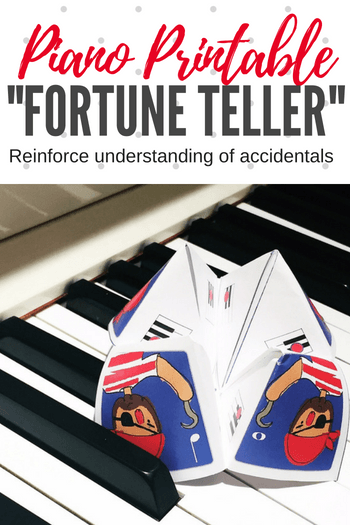The introduction to sharps and flats can be frustrating for some piano students. Just when they think they are finally getting a grip on note reading… accidentals enter the picture.
Of course, the introduction to sharps and flats doesn’t have to be frustrating. In fact, it shouldn’t be frustrating… it should be fun! If your students’ first experiences with sharps and flats (or any other concepts for that matter!) are positive, they will be much less likely to fear them moving forward.
So in today’s post we’re sharing a cool pirate-themed printable that you can use to help your piano students learn (or review) the concept of sharps and flats in a hands-on way.

Help Captain Sharpbeard Find His Treasure…
Get ready to pump up the enjoyment in your studio with Captain Sharpbeard! In this fun activity you’ll use a “fortune teller” manipulative to bring learning to life. You can download the Pirate Fortune Teller Printable here. If you remember using “Fortune Tellers” as a child, then you’ll know exactly what to do. If not, we’ve included folding instructions on the printable.
How To Play:
Before the game begins, construct your Fortune Teller Printable. Next, have your piano student place a game marker on any black key on the piano that falls between Middle C and Treble C. While he is doing this, decide where “Captain Sharpbeard” has “buried his treasure” by secretly choosing any sharp or flat and writing its name on a slip of paper. Set the slip of paper aside. Note: Your student wins the game if the game marker moves within one black key of your secret “buried treasure”.
Visual learners can check out the video below.
- The top of the Fortune Teller contains 4 pictures of Captain Sharpbeard, “pointing” at a rhythmic value.
- Have your student choose a note value and name the beats that the note value receives in 4/4 time.
- Manipulate your Fortune Teller according to the number of beats selected by your student.
- The Fortune Teller will now be “open” and groups of black keys will be visible.
- Have your student point to and name one of the “marked” black keys.
- If the named key in Step 5 is part of a group of 2 black keys, manipulate the Fortune Teller two times. If the named key in Step 4 is part of a group of 3 black keys, manipulate the Fortune Teller three times.
- Repeat Steps 4 – 6 again.
- The Fortune Teller will now be “open” and groups of black keys will be visible. Have your student select a flap by naming one of the four black keys marked with a circle.
- Open the flap associated with your student’s selection in Step 8.
- According to the directions on the inside of the flap, have your student move his game marker from its original resting place on the piano to a new black key.
- Repeat Steps 2 to 10 three more times so that your student’s game marker moves to three different locations. After the third time, leave the game marker in its final position on the piano.
- Finally, open the secret slip of paper that indicates where Captain Sharpbeard’s accidental treasure was buried. Is your student’s game marker within one black key of the accidental you wrote down? If yes… he wins!
Reinforcing Accidentals With Half Step Henry
Looking for another out-of-the-box accidental adventure? The Accidental Adventures of Half Step Henry is a loveable resource that is perfect to use as a first introduction to accidentals or as a review if needed.
Elementary-level piano students will bust a gut as they follow Henry on a laugh-out-loud adventure while learning all about accidentals. The book includes instructional pages, lots of focussed practice, repertoire, a duet, and even a cut-and-play piano game! You can find The Accidental Adventures of Half Step Henry on Amazon here.


Arrrr! Me grateful for thee pirate treasure! 🙂
Glad to hear it Jennifer! 🙂
Thank you Andrea! Have you ever tried laminating these? Or is there another way to make them last longer?
Hi Shelley – laminating them would make the folding impossible (unfortunately! I LOVE laminating things!). I have them printed on slightly heavier paper that has a bit of gloss to it. This way they still fold but keep their shape longer. If you print at Staples you have a wide variety of paper choices and I go with a mid-weight paper.
It’s like Christmas every time you come up with a new learning tool! I appreciate your creativity and willingness to share SO MUCH! Thanks a million!
…oh and Christmas is just around the corner and we go really crazy with the freebies then! 😉 Glad you enjoy our blog Gaylinn! Thanks so very much for reading.
Such a fun and creative way to use the fortune teller game! I’m looking forward to using this with my students. Thanks for sharing.
Oh my goodness, I can’t get the pockets to work. I’ll have to wait til a student arrives. I’m sure they’ll know. I watched the video and everything. Hilarious! Am doing something wrong, and can’t figure it out.
Still can’t get this to work according to instructions. No students can make it work either. Can anyone help?
What is a cover? Fold all covers to the center? Thanks
this doesn’t work.
I parent fixed it. oh my goodness!